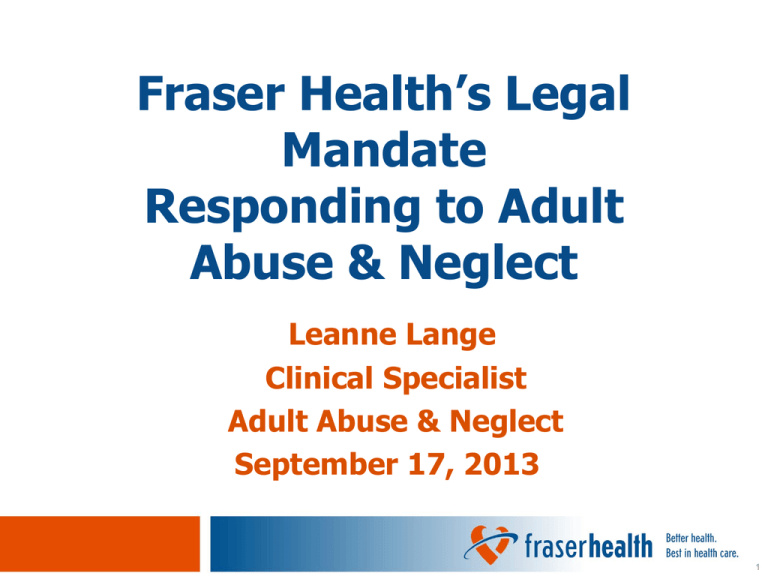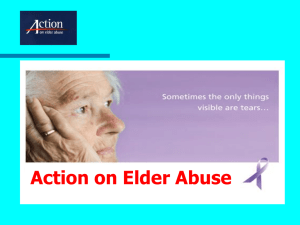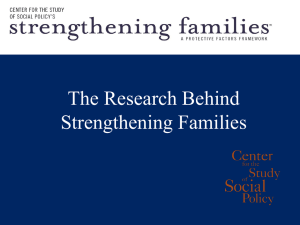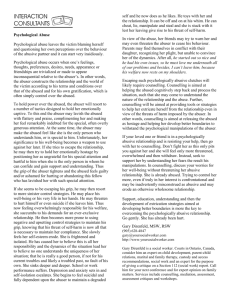
Fraser Health’s Legal
Mandate
Responding to Adult
Abuse & Neglect
Leanne Lange
Clinical Specialist
Adult Abuse & Neglect
September 17, 2013
1
Overview
Prevalence
Fraser Health is a Designated Agency - The
Designated Responders
What is abuse, neglect, & self-neglect?
Why are these situations so complex?
How to make a report
Adult Guardianship Act
2
Prevalence
4 % of Canadian seniors suffer from one or
more serious forms of abuse by a spouse,
relative or other close contact
1 out of 12 seniors in BC have been
financially abused in amounts that average
over $20,000
Almost half of all violence against seniors
occurs in spousal relationships
3
Prevalence
Older women are the victims in about
2/3 of the cases that come to the attention of
community agencies
Only about 1 in 5 cases of abuse come to the
attention of community agencies or authorities
4
BC’s Adult Guardianship Legislation
Adult Guardianship Act (Part 3)
Health Care (Consent) and Care Facility
(Admission) Act
Representation Agreement Act
Public Guardian & Trustee Act
5
Adult Guardianship Act- Part 3
The Purpose
Abused, neglected & self-neglected and
unable to seek support and assistance due to:
Physical restraint
A physical handicap that limits their ability to
seek help or
An illness, disease, injury or other condition
that affects their ability to make decisions
about the abuse or neglect
6
Guiding Principles
Self Determination & Choice
Most Effective but Least Intrusive Support,
Assistance, or Protection
Adults are Presumed Capable
Court as the Last Resort
7
Who are the Designated Agencies?
All Health Authorities
Community Living BC (for adults with
developmental disabilities)
8
Location of the Adult
Adult’s Home
Relative’s Home
Private Care Facility
First Nations Communities
Other than a correctional facility
9
The Designated Responders in Fraser
Health
Acute Care
Home Health
Mental Health & Substance Use
Acquired Brain Injury Program
Palliative Care & End of Life
Owned Residential Care Facilities
Contracted Residential Care Facilities
10
Definition of Abuse
The deliberate mistreatment of an adult that
causes the adult:
Physical, mental or emotional harm, or
Damage to or loss of assets
11
Examples of Abuse
Intimidation
Humiliation
Physical assault
Sexual assault
Over/Under medication
Withholding needed medication
Censoring mail
Invasion or denial of privacy
Denial of access to visitors
Theft
12
Indicators of Sexual & Physical Abuse
Bruises, black eyes
Welts, rope marks
Broken assistive devices
Lacerations
Fractures, sprains, dislocations
Burns
Repeated falls
Explanation does not match the injury
Adult’s report of being abused
13
Emotional Abuse
Any act which diminishes an adult’s sense of
identity, dignity and self-worth
Confinement
Isolation
Verbal assault
Humiliation
Intimidation
Infantilization
14
Indicators of Financial Abuse
Unpaid Bills
No money for basic necessities
Sudden sale or change in property ownership
Adult complains about not knowing where
money has gone
Decision maker refuses to spend money on the
adult’s behalf
Power of Attorney granted under unusual
circumstances
Sudden changes in types and amounts of
withdrawals
15
Definition of Neglect & Self-Neglect
Any failure to provide necessary care,
assistance guidance or attention to an
adult that causes, or is reasonably
likely to cause within a short period
of time, the adult serious physical,
mental or emotional harm or substantial
damage to or loss of assets, and includes
self-neglect
16
Indicators of Neglect/Self-Neglect
Malnourished
Emaciated
Dehydrated
Confused
Inappropriate Clothing
Squalor
Over/Under medicated
Absence of required hearing, visual, mobility aids
Skin sores
Malodorous
No follow through on medical services
17
Understanding the Dynamics
SITUATION
ABUSER
ABUSED ADULT
18
SITUATION
Poverty
History of violence
Cultural behaviour
Social isolation
Marital conflict
Overcrowding
Lack of family support
Lack of social support
19
ABUSED ADULT
Functional dependence
Poor health/impairment
Age & gender
Economic dependency
Intergenerational conflict
Substance Abuse
History of abuse or abuser
Stoicism/Internalizes blame
Presence of problem behaviours
Impaired judgment/insight
20
ABUSER
Alcohol/drug user
Mental/emotional problems
Lack of caregiving experience
Abused as child/adult
Stressed
Confused/demented
Financially dependent
Poor social connections
Need for control
Unsympathetic
21
Hallmarks of Abuse
Control of finances
Control of access
Isolation
Alienation of previous support network
Ingratiation to the victim of abuse
Threats & intimidation to those trying to help
22
Barriers to Disclosure
Hopelessness and isolation, may blame self
Values and beliefs (personal, cultural, familial)
Hope the abuser will stop without intervention
Fear of reprisals
Fear of abandonment
Functional or communication challenges
Lack of awareness and information re:
personal and legal rights
23
Our Investigation Answers
2 Pivotal Questions
Is the adult being abused, neglected, or
self-neglecting?
Is the adult able to get help on their
own?
24
What Fraser Health Must Do During
the Investigation
Look into the situation
Involve the adult as much as possible
Determine if the adult needs support &
assistance
Report criminal offences to the police
Keep the identity of the person who made the
report confidential
25
Legal Tools
Protecting the Adult
Warrant to enter to conduct an interview
Access Order to enter (health care provider)
Interim Restraining Order (up to 90 days)
Support & Assistance Order (may include a
long term restraining order)
26
Legal Tools
Emergency Assistance – Section 59
Enter the premises where adult is located & use any
reasonable force necessary
Provide emergency health care
Remove an adult and take to a “safe” place
Protect assets by informing the Public Guardian &
Trustee
Protect the adult from harm using any other measure
necessary
27
How to Make a Referral to Fraser
Health
Home Health Referral Line
1-855-412-2121
28
Contact Information
Leanne Lange, Clinical Specialist, Adult
Abuse & Neglect
Tel: 604-777-7393
Cell: 604-807-6838
Fax: 604-777-7392
Email: leanne.lange@fraserhealth.ca
29










